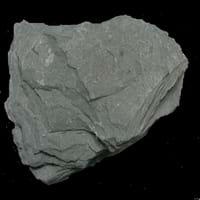Definition
Chalk is a soft, white, powdery limestone consisting mainly of fossil shells of foraminifers
Slate is a fine-grained, foliated, homogeneous metamorphic rock derived from an original shale-type sedimentary rock composed of clay or volcanic ash through low-grade regional metamorphism
Discoverer
Unknown
Unknown
Etymology
From old English cealc chalk, lime, plaster; pebble, from Greek khalix small pebble, in English transferred to the opaque, white, soft limestone
From Old French esclate, from esclat (French éclat)
Class
Sedimentary Rocks
Metamorphic Rocks
Sub-Class
Durable Rock, Soft Rock
Durable Rock, Medium Hardness Rock
Group
Not Applicable
Not Applicable
Other Categories
Fine Grained Rock, Opaque Rock
Fine Grained Rock, Opaque Rock
Texture
Clastic or Non-Clastic
Foliated
Color
Grey, White, Yellow
Black, Brown, Buff, Green, Light to Dark Grey, Purple, Red, Shades of Blue
Durability
Durable
Durable
Interior Uses
Decorative Aggregates, Homes, Interior Decoration
Bathrooms, Decorative Aggregates, Entryways, Floor Tiles, Flooring, Homes, Hotels, Interior Decoration, Kitchens, Stair Treads
Exterior Uses
As Building Stone, As Facing Stone, Paving Stone, Garden Decoration
As Building Stone, As Facing Stone, Garden Decoration, Paving Stone
Other Architectural Uses
Powder
Curbing
Construction Industry
As Dimension Stone, Cement Manufacture, Construction Aggregate, for Road Aggregate, Making natural cement, raw material for manufacture of quicklime and slaked lime, Source of calcium
As Dimension Stone
Medical Industry
Not Yet Used
Not Yet Used
Antiquity Uses
Artifacts, Monuments, Sculpture, Small Figurines
Artifacts, Monuments, Sculpture, Small Figurines
Commercial Uses
Alumina Refineries, Creating Artwork, Drawing on blackboards, Gymnasts, athletes and mountain climbers use for grip, In aquifers, Paper Industry, Production of Lime, Raw material for manufacture of quicklime, slaked lime, Soil Conditioner, Whiting, Whiting material in toothpaste, paint and paper
Blackboards, Commemorative Tablets, Laboratory bench tops, Standard material for the bed of Billiard table, Standard material for the beds of Pool and Snooker table, Tombstones, Used in aquariums, Writing Slates
Types
Not Available
Not Available
Features
Clasts are smooth to touch, Is one of the oldest rock, Smooth to touch, Very fine grained rock
Easily splits into thin plates, Surfaces are often shiny, Very fine grained rock
Archaeological Significance
Famous Monuments
Data Not Available
Data Not Available
Famous Sculptures
Data Not Available
Data Not Available
Formation
Chalk is formed from lime mud, which accumulates on the sea floor which is then transformed into rock by geological processes.
Slate is a low grade metamorphic rock that is generally formed by metamorphosis of mudstone or shale, under relatively low pressure and temperature conditions.
Mineral Content
Calcite, Clay, Clay Minerals, Quartz, Sand
Apatite, Biotite, Chlorite, Feldspar, Graphite, Hematite, Kaolinite, Magnetite, Pyrite, Tourmaline, Zircon
Compound Content
Ca, NaCl, CaO
Aluminium Oxide, CaO, Iron(III) Oxide, Potassium Oxide, MgO, Sodium Oxide, Silicon Dioxide, Titanium Dioxide
Types of Metamorphism
Not Applicable
Burial Metamorphism, Cataclastic Metamorphism, Regional Metamorphism
Types of Weathering
Biological Weathering, Chemical Weathering
Biological Weathering, Chemical Weathering, Mechanical Weathering
Types of Erosion
Chemical Erosion, Coastal Erosion, Water Erosion
Coastal Erosion, Glacier Erosion, Water Erosion, Wind Erosion
Grain Size
Very fine-grained
Very fine-grained
Fracture
Not Available
Splintery
Streak
White
Light to dark brown
Porosity
Highly Porous
Less Porous
Compressive Strength
Not Available
Cleavage
Non-Existent
Slaty
Specific Gravity
2.3-2.4
2.65-2.8
Transparency
Opaque
Opaque
Density
2.49-2.50 g/cm3
2.6-2.8 g/cm3
Resistance
Heat Resistant
Heat Resistant, Impact Resistant, Pressure Resistant, Wear Resistant
Deposits in Eastern Continents
Asia
Brunei, India, Indonesia, Malaysia, Singapore, Thailand, Vietnam
China, India, Turkey
Africa
Cameroon, Chad, Ghana, Kenya, Malawi, Sudan, Tanzania, Togo, Zambia, Zimbabwe
Not Yet Found
Europe
England, France, Germany, Spain, United Kingdom
Belgium, France, Germany, Italy, Norway, Portugal, Spain, United Kingdom
Others
Not Yet Found
Arctic
Deposits in Western Continents
North America
Canada, USA
USA
South America
Colombia
Brazil
Deposits in Oceania Continent
Australia
Adelaide, New Zealand, Queensland, Tonga, Victoria, Yorke Peninsula
Not Yet Found
All about Chalk and Slate Properties
Know all about Chalk and Slate properties here. All properties of rocks are important as they define the type of rock and its application. Chalk belongs to Sedimentary Rocks while Slate belongs to Metamorphic Rocks.Texture of Chalk is Clastic or Non-Clastic whereas that of Slate is Foliated. Chalk appears Soft and Slate appears Dull. The luster of Chalk and Slate is dull. Chalk is available in grey, white, yellow colors whereas Slate is available in black, brown, buff, green, light to dark grey, purple, red, shades of blue colors. The commercial uses of Chalk are alumina refineries, creating artwork, drawing on blackboards, gymnasts, athletes and mountain climbers use for grip, in aquifers, paper industry, production of lime, raw material for manufacture of quicklime, slaked lime, soil conditioner, whiting, whiting material in toothpaste, paint and paper and that of Slate are blackboards, commemorative tablets, laboratory bench tops, standard material for the bed of billiard table, standard material for the beds of pool and snooker table, tombstones, used in aquariums, writing slates.









